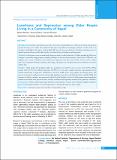Please use this identifier to cite or link to this item:
https://hdl.handle.net/20.500.14356/1383Full metadata record
| DC Field | Value | Language |
|---|---|---|
| dc.contributor.author | Devkota, Rashmi | - |
| dc.contributor.author | Mishra, Kamana | - |
| dc.contributor.author | Shrestha, Shovana | - |
| dc.date.accessioned | 2023-05-09T09:25:50Z | - |
| dc.date.available | 2023-05-09T09:25:50Z | - |
| dc.date.issued | 2019 | - |
| dc.identifier.citation | DevkotaR., MishraK., & ShresthaS. (2019). Loneliness and Depression among Older People Living in a Community of Nepal. Journal of Nepal Health Research Council, 17(2), 185-192. https://doi.org/10.33314/jnhrc.v0i0.1561 | en_US |
| dc.identifier.issn | Print ISSN: 1727-5482; Online ISSN: 1999-6217 | - |
| dc.identifier.uri | http://103.69.126.140:8080/handle/20.500.14356/1383 | - |
| dc.description | Original Article | en_US |
| dc.description.abstract | Abstract Background: Loneliness and depression are the noteworthy mental health issues which are prevalent among older people but only a few studies have addressed this aspect especially in developing countries. So, this study is an attempt to shed light to this aspect of older adult’s life, in order to assess the level of loneliness and depression, to identify associated factors,and to find out the correlation between loneliness and depression. Methods: A descriptive cross-sectional study design was used to collect data from 124 older peopleof age ?60 years living in a community using purposive sampling technique. A structured questionnaire, University of California, Los Angeles scale version 3 loneliness scale, and geriatric depression scale short form (GDS-15) were used to collect data. Mean, Standard deviation, frequency, percentage, chi-square test, and Spearman rank correlation was used to analyze data. Results: Older people felt loneliness either at a moderate level (38.7%) or at a severe level (16.9%). While people with (49.2%) and without depression (50.80%) were in nearly equal proportion. Age,education level, marital status,living arrangement, childlessness, perceived health status, sleep quality, and sleeping hour, and perceived economic satisfaction showed statistically significant association with both dependent variables.While the presence of disease condition was associated with the level of loneliness, the level of depression showed significant statistical association with perceived stress. Further, loneliness and depression seemed to be positively correlated.Conclusions: Older peopleexperiencing loneliness and depression is quite noteworthyand emphasis should be given towards implementation of research approaches to unleash this aspect of older people. Keywords: Community; depression; loneliness; Nepal; older people | en_US |
| dc.language.iso | en | en_US |
| dc.publisher | Nepal Health Research Council | en_US |
| dc.relation.ispartofseries | Apr-June, 2019;1561 | - |
| dc.subject | Community | en_US |
| dc.subject | Depression | en_US |
| dc.subject | Loneliness | en_US |
| dc.subject | Nepal | en_US |
| dc.subject | older people | en_US |
| dc.title | Loneliness and Depression among Older People Living in a Community of Nepal | en_US |
| dc.type | Journal Article | en_US |
| local.journal.category | Original Article | - |
| Appears in Collections: | Vol. 17 No. 2 Issue 43 Apr - Jun 2019 | |
Files in This Item:
| File | Description | Size | Format | |
|---|---|---|---|---|
| 1561-Manuscript-10743-1-10-20190804.pdf | Fulltext Download | 257.82 kB | Adobe PDF |  View/Open |
Items in DSpace are protected by copyright, with all rights reserved, unless otherwise indicated.
